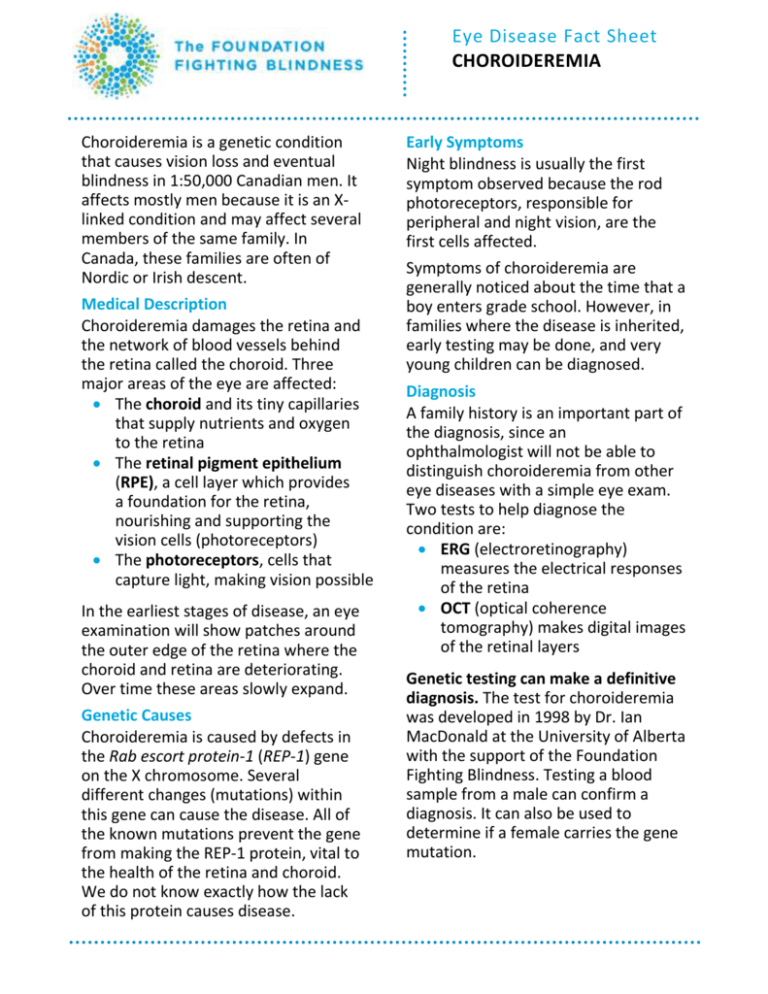DOC - The Foundation Fighting Blindness
advertisement

Eye Disease Fact Sheet CHOROIDEREMIA Choroideremia is a genetic condition that causes vision loss and eventual blindness in 1:50,000 Canadian men. It affects mostly men because it is an Xlinked condition and may affect several members of the same family. In Canada, these families are often of Nordic or Irish descent. Medical Description Choroideremia damages the retina and the network of blood vessels behind the retina called the choroid. Three major areas of the eye are affected: The choroid and its tiny capillaries that supply nutrients and oxygen to the retina The retinal pigment epithelium (RPE), a cell layer which provides a foundation for the retina, nourishing and supporting the vision cells (photoreceptors) The photoreceptors, cells that capture light, making vision possible In the earliest stages of disease, an eye examination will show patches around the outer edge of the retina where the choroid and retina are deteriorating. Over time these areas slowly expand. Genetic Causes Choroideremia is caused by defects in the Rab escort protein-1 (REP-1) gene on the X chromosome. Several different changes (mutations) within this gene can cause the disease. All of the known mutations prevent the gene from making the REP-1 protein, vital to the health of the retina and choroid. We do not know exactly how the lack of this protein causes disease. Early Symptoms Night blindness is usually the first symptom observed because the rod photoreceptors, responsible for peripheral and night vision, are the first cells affected. Symptoms of choroideremia are generally noticed about the time that a boy enters grade school. However, in families where the disease is inherited, early testing may be done, and very young children can be diagnosed. Diagnosis A family history is an important part of the diagnosis, since an ophthalmologist will not be able to distinguish choroideremia from other eye diseases with a simple eye exam. Two tests to help diagnose the condition are: ERG (electroretinography) measures the electrical responses of the retina OCT (optical coherence tomography) makes digital images of the retinal layers Genetic testing can make a definitive diagnosis. The test for choroideremia was developed in 1998 by Dr. Ian MacDonald at the University of Alberta with the support of the Foundation Fighting Blindness. Testing a blood sample from a male can confirm a diagnosis. It can also be used to determine if a female carries the gene mutation. What to Expect Boys with choroideremia usually have vision loss in grade school. Most men with choroideremia will gradually lose their peripheral vision resulting in legal blindness by age 40. Many men will become completely blind by age 70-80. About 30% of women who carry a REP1 mutation may develop some symptoms of vision loss, typically in mid-life. A woman’s vision loss is rarely as severe as a man’s. Treatment No treatments are currently approved for choroideremia however it is important to have your eyes monitored regularly for any changes or complications. Research In November 2011, the first clinical trial of gene therapy for choroideremia began in the UK led by Dr. Robert MacLaren of Oxford University. The therapy aims to replace the mutated REP-1 gene with a healthy copy. This healthy gene will hopefully allow the retina to produce the missing protein. In June 2015, a team of scientists based at the University of Alberta, led by Dr. MacDonald, initiated the first Canadian site of this clinical trial. This research is being funded by the Foundation Fighting Blindness, and our partners at Alberta Innovates Health Solutions, the Canadian Institutes of Health Research and the Choroideremia Research Foundation Canada. Updated December 23, 2015: Dr. Mary Sunderland, Director of Research & Education, Foundation Fighting Blindness. Reviewed by Dr. Ian MacDonald, Chair, Department of Ophthalmology at the University of Alberta. What does X-linked Mean? Chromosomes are complex strings of genes. Each person has 23 pairs of chromosomes. One half of each pair comes from each parent. Thus, we have duplicate copies of most genes – a back-up against disease caused by gene damage. Only one gene in each pair is usually active within a cell. Since some cells draw on one half of the pair and other cells the opposite half, our bodies become a unique blend. One pair of chromosomes is different. This pair is made up of the X and Y chromosomes and determines gender. These sex chromosomes carry many different sorts of genes; most of the genes on X are missing from Y. REP1 is one of these. Men inherit an X from their biological mother, and a Y from their biological father, thus men have no protective back-up, if their REP1 gene (or another X-linked gene) is mutated. This is why boys can develop choroideremia. Daughters of affected men are all carriers meaning that they are not affected, but that some of their children may inherit the disease. Sons of affected men will not develop symptoms (and are not carriers). Women have two X chromosomes, one from each parent. If a girl has an affected father, she will inherit a mutated REP1 gene from her father and a healthy REP1 gene from her mother. She will not inherit the full disease, but her sons have a 50% risk of developing choroideremia and her daughters have a 50% risk of being carriers. Support sight-saving research with your donation to the Foundation Fighting Blindness 1.800.461.3331 www.ffb.ca








